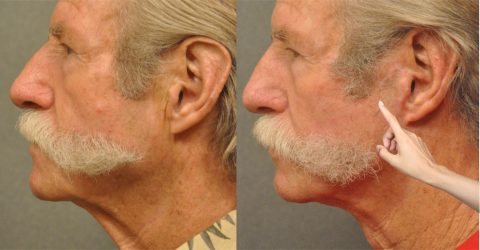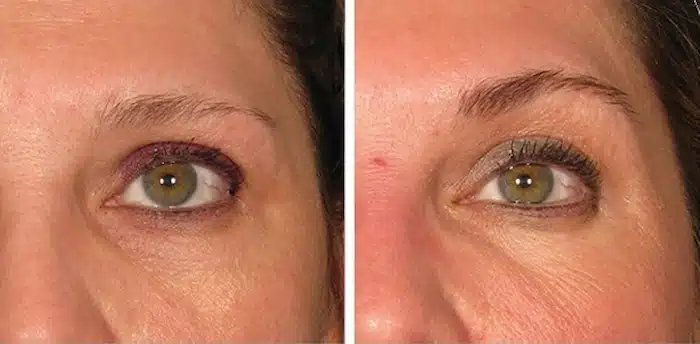Facelifts are designed to restore youthful contours, but subtle clues can still give them away. If you’re wondering how to tell if someone has had a facelift, Dr. Joel Kopelman of Kopelman Aesthetic Surgery explains the most common signs of a facelift and how to distinguish natural results from obvious ones.
Table of Contents
ToggleKey Signs of a Facelift
Certain physical traits may reveal facelift procedures, even when results are subtle:
- Tight jawline and neck: A sharp contrast between the lifted lower face and aging areas like the chest can indicate facelift surgery.
- Elevated cheeks or smooth nasolabial folds: May result from repositioned facial tissues, not just skin tightening.
- Minimal movement in midface or brows: Tightening the skin and deeper support layers may reduce animation in these areas.
While none of these signs confirm surgery, a combination can tell.
Facelift Scars and Changes Around the Ears
One of the most common telltale signs is scarring near the ears:
- Scars in front of the ears or behind them are often hidden in natural creases, but close inspection may reveal them.
- Pixie ear deformity: When the earlobe appears pulled downward and attached to the face, this is a classic sign of pulling the skin too tightly.
- Distorted earlobe shape: Changes in volume or positioning of the earlobe may result from excessive traction or improper tension.
Advanced facial plastic surgery techniques now help minimize visible scarring, especially when performed by experienced plastic surgeons like Dr. Kopelman.
Signs of a Bad or Botched Facelift
Not all facelift results are subtle or successful. Poor technique or healing can lead to:
- Unnatural facial expressions due to excessive skin tension.
- Facial asymmetry or hollowed areas when fat or tissue is unevenly repositioned.
- Visible scarring along the hairline, jawline, or behind the ears.
These outcomes are often associated with underqualified providers or high-volume plastic surgery clinics that don’t offer personalized care.
Facelift vs. Fillers: How to Tell the Difference
Fillers and facelift procedures can both improve facial rejuvenation, but their effects differ:
- Facelift surgery repositions deeper facial tissues, especially in the lower face and neck.
- Dermal fillers typically address volume loss, especially in the cheeks or under the eyes.
- Fillers may create puffiness or smoothness in areas not typically lifted by a facelift.
An experienced eye—like that of Dr. Kopelman—can often tell which method was used based on facial volume, motion, and texture.
Do You Need a Facelift? How to Know
Not every aging concern requires surgery. You might consider a facelift if:
- You notice persistent sagging skin along your jaw or neck.
- Fillers no longer provide satisfying results.
- You want long-term improvement in facial contour, not just surface changes.
Kopelman Aesthetic Surgery helps patients evaluate these signs and recommends safe, tailored treatment plans.
What a Natural Facelift Looks Like—and Whether People Notice
A well-done facelift should not be obvious. Here’s what to expect with a natural facelift result:
- Facial harmony: The lifted areas match the surrounding untreated zones.
- No sharp tension: There is a definition without over-pulled skin.
- Expression preserved: Smiles, brows, and eye movement appear natural.
Most patients find that when results are natural, friends notice they look refreshed but can’t pinpoint why.
What to Know About the 20-Minute Facelift
The “20 minute facelift” is often marketed as a quick fix, but it has limitations:
- It is a non-surgical or mini-lift procedure that may improve mild laxity.
- It does not reposition deeper facial tissues or address significant sagging.
- The results are temporary and subtle.
Always consult a board-certified plastic surgeon before considering these options to set realistic expectations.
Dr. Joel Kopelman’s Approach to Subtle Results
With over 35 years of experience, Dr. Kopelman specializes in advanced facial plastic surgery, including deep plane facelifts and neck lift techniques that prioritize subtlety and symmetry. He avoids the common signs of a bad facelift by:
- Tailoring each procedure to individual anatomy.
- Preserving natural expression and movement.
- Strategically hiding incisions and minimizing tension on the skin.
Patients who choose Kopelman Aesthetic Surgery benefit from deep expertise, careful planning, and results that enhance rather than alter.

























